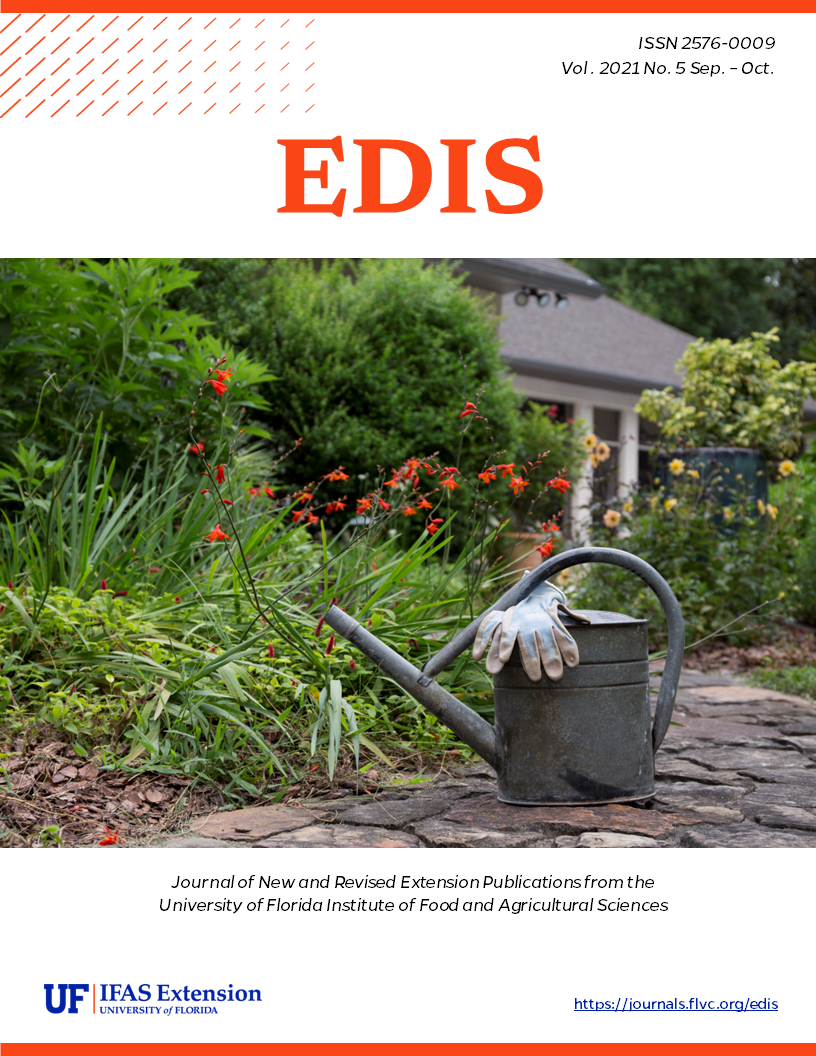Abstract
This article details three adventive (to North America) psyllid species that feed on ficus. Homotoma ficus (the fig psylla) was noticed first in 1969, and Macrohomotoma gladiata (the curtain fig psyllid) and Trioza brevigenae (the ficus leaf rolling psyllid) were found to be present in 2015 and 2016, respectively. All three three species are currently found only in California, but could possibly spread to other states including Florida in the future.
References
Burckhardt D. 1994. Generic key to Chilean jumping plant-lice (Homoptera: Psylloidea) with inclusion of potential exotic pests. Revista Chilena de Entomología 21: 57-67.
Burckhardt D, Cho G, Lee S. 2018. Moriphila furva gen. and sp. nov. (Hemiptera: Psylloidea: Homotomidae), a new jumping plant-louse from Korea associated with Morus australis (Moraceae). Zootaxa 4444: 299-315. https://doi.org/10.11646/zootaxa.4444.3.5
Burckhardt D, Ouvrard D, Queiroz D, Percy, D. 2014. Psyllid host-plants (Hemiptera: Psylloidea): resolving a semantic problem. Florida Entomologist 97: 242-246. https://doi.org/10.1653/024.097.0132
CAS. 2017. California Agriculture Statistic Review, 2016-2017. California Department of Food and Agriculture, Sacramento, CA. https://www.cdfa.ca.gov/Statistics/PDFs/2016-17AgReport.pdf
Compton SG, Stavrinides M, Kaponas C, Thomas PJ. 2020. No escape: most insect colonisers of an introduced fig tree in Cyprus come from the plant’s native range. Biological Invasions 22: 211-216. https://doi.org/10.1007/s10530-019-02132-4
Dara SK, Hodel DR. 2015. Weeping fig thrips (Thysanoptera: Phlaeothripidae) in California and a review of its biology and management options. Journal of Integrated Pest Management 6: 2. https://doi.org/10.1093/jipm/pmv001
Gencer NS, Coskuncu KS, Kumral NA. 2007. The colonization preference and population trends of larval fig psylla, Homotoma ficus L. (Hemiptera: Homotomidae). Journal of Pest Science 80: 1-8. https://doi.org/10.1007/s10340-006-0140-y
Halbert SE, Burckhardt D. 2020. The psyllids (Hemiptera: Psylloidea) of Florida: newly established and rarely collected taxa and checklist. Insecta Mundi 0788: 1-88.
Hilbert DR, Koeser AK, Roman LA, Hamilton K, Landry SM, Hauer RJ, Campanella H, McLean D, Andreu M, Perez H. 2019. Development practices and ordinances predict inter-city variation in Florida urban tree canopy coverage. Landscape and Urban Planning 190: 103603. https://doi.org/10.1016/j.landurbplan.2019.103603
Hodel DR, Arakelian G, Ohara LM, Wilen C, Dara SK. 2016. The Ficus leaf-rolling psyllid. PalmArbor 2: 1-9.
Hodel DR, Komen J, Ohara LM, Arakelian A, Rugman-Jones PF. 2020. Another look at the Ficus leaf-rolling psyllid. PalmArbor 2020-15: 1-31. https://ucanr.edu/sites/HodelPalmsTrees/files/337566.pdf
Hollis D, Broomfield PS. 1989. Ficus-feeding psyllids (Homoptera), with special reference to the Homotomidae. Bulletin of the British Museum of Natural History, Entomology 58: 131–183.
Jerinić-Prodanović D. 2011. The first finding of the fig psylla Homotoma ficus L (Hemiptera, Psylloidea, Homotomidae) in Serbia. Pesticidi i Fitomedicina 26: 205-212. https://doi.org/10.2298/PIF1103205J
Johnson NF, Triplehorn CA. 2005. Borror and DeLong's Introduction to the Study of Insects, 7th ed. Thompson Brooks/Cole, Belmont, CA.
Ko CC, Shih YT, Schmidt S, Polaszek A. 2015. A new species of Encarsia (Hymenoptera, Aphelinidae) developing on ficus whitefly Singhiella simplex (Hemiptera, Aleyrodidae) in China and Taiwan. Journal of Hymenoptera Research 46: 85-90. https://doi.org/10.3897/JHR.46.5155
Kuwayama S. 1908. Die Psylliden Japans. I. Transactions of the Sapporo Natural History Society 2: 149-189.
Laborda R, Galán-Blesa J, Sánchez-Domingo A, Xamaní P, Estruch VD, Selfa J, Guerrieri E, Rodrigo E. 2015. Preliminary study on the biology, natural enemies and chemical control of the invasive Macrohomotoma gladiata (Kuwayama) on urban Ficus microcarpa L. trees in Valencia (SE Spain). Urban Forestry & Urban Greening 14:123-128. https://doi.org/10.1016/j.ufug.2014.12.007
Lubanga UK, Guédot C, Percy DM, Steinbauer MJ. 2014. Semiochemical and vibrational cues and signals mediating mate finding and courtship in Psylloidea (Hemiptera): A synthesis. Insects 5: 577-595. https://doi.org/10.3390/insects5030577
Pedata PA, Burckhardt D, Mancini D. 2012. Severe infestations of the jumping plant-louse Macrohomotoma gladiata, a new species for Italy in urban Ficus plantations. Bulletin of Insectology 65: 95-98.
Rung A. 2016. A new pest of ficus in California: Macrohomotoma gladiata Kuwayama, 1908 (Hemiptera: Psylloidea: Homotomidae), new to North America. Check List 12: 1882. https://doi.org/10.15560/12.3.1882

